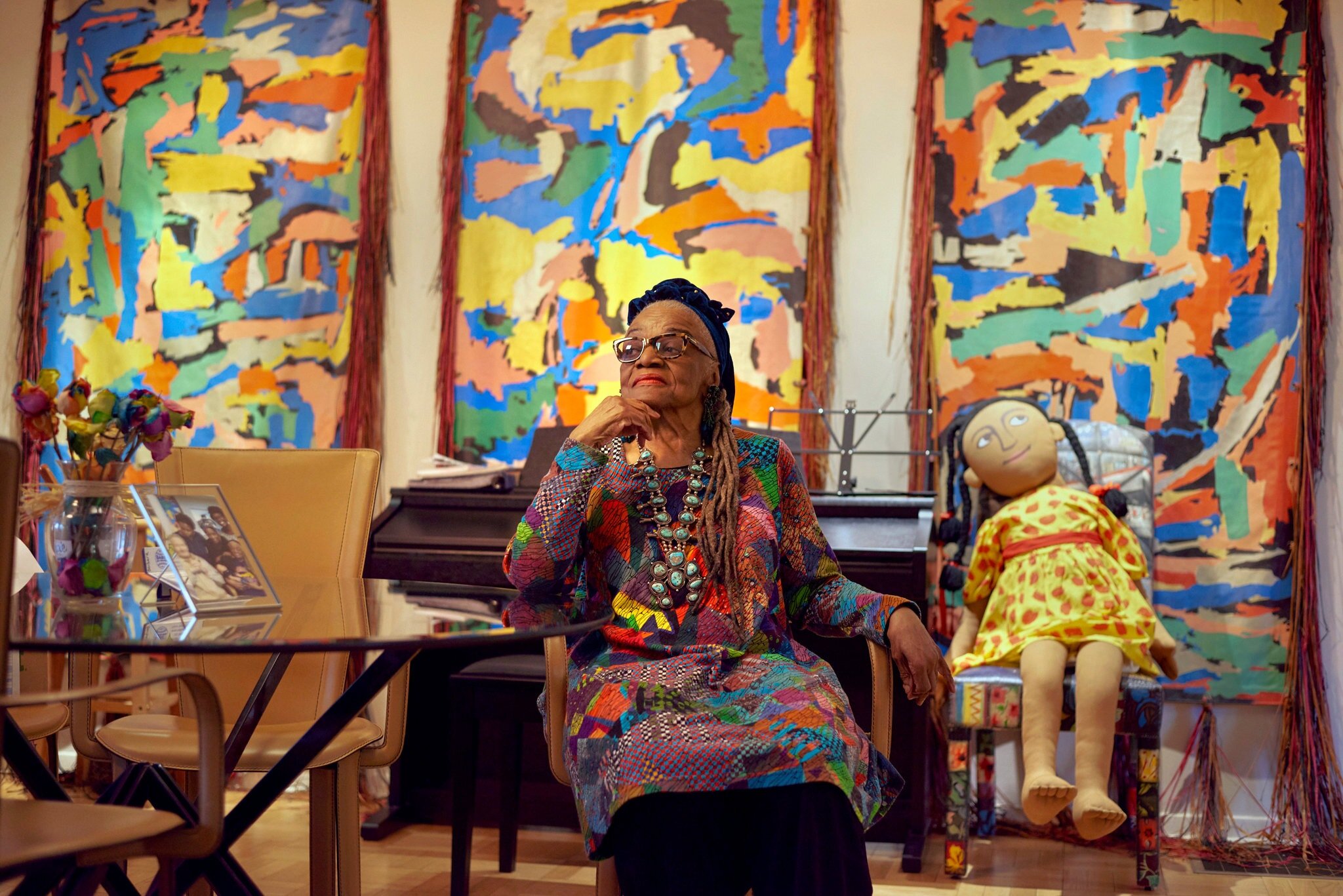FAITH RINGGOLD (b. 1930, USA)
Faith Ringgold, born 1930 in Harlem, New York, is painter, writer, children’s author, mixed media sculptor, and performance artist, best known for her narrative quilts. She received her B.S. and M.A. degrees in visual art from the City College of New York in 1955 and 1959. Professor Emeritus of Art at the University of California in San Diego, Ringgold has received 23 Honorary Doctorates. Faith Ringgold is the mother of two daughters, Michele and Barbara Wallace.
A fervent civil rights and gender equity activist, Ringgold’s work is inherently political. Ringgold’s oil paintings and posters begun in the mid-to-late 1960s carried strong political messages in support of the civil-rights movement. In the early 1970s, she abandoned traditional oils for painting in acrylic on unstretched canvas with fabric borders. The painted narrative quilts for which Ringgold is best known grew out of these early paintings. Ringgold also personally demonstrated against the Museum of Modern Art and the Whitney over their exclusion of black and female artists. She protested outside New York museums demanding equal gender and racial representation in exhibitions, designed political posters and co-organised the People’s Flag Show, for which she was arrested in 1970 (lawyers from the American Civil Liberties Union provided counsel and all of the charges were subsequently dropped).
Ringgold’s first solo gallery shows were held in 1967 and 1970 at the cooperative Spectrum Gallery, New York. Retrospectives of her work have been organized by Rutgers University, New Brunswick (1973), the Studio Museum in Harlem, New York (1984), and the Fine Arts Museum of Long Island, Hempstead (1990). Ringgold’s work has been included in numerous exhibitions devoted to political art, women’s art, contemporary quilts, and African-American art, as well as in the Whitney Biennial (1985). Her achievements as an artist, teacher, and activist have been recognized with numerous honors, including National Endowment for the Arts awards in sculpture (1978) and painting (1989), a John Simon Guggenheim Memorial Foundation Fellowship (1987. Ringgold’s work is included in a number of museum collections, including MoMA, The Guggenheim, and The Metropolitan Museum of Art.
“To Selma Burke 1900 -1995 Dear Selma, Everytime I see a dime I think of you. In 1944 when President Franklin Delano Roosevelt posed for your portrait plaque of him, little did you know this masterful relief profile would show up without attribution, on the dime in 1945 — for all the world to see. Faith Ringgold 11/13/10”
Dear Selma, Every Time I See A Dime, I Think Of You, 2010
Serigraph (screen print)
35 x 27 1/4 in
Ed 21/65
Courtesy of Susanna Gold Gallery
“Throughout her career, Ringgold’s work has been driven by the challenges and fulfillments of her life and the lives of those around her. ‘First of all, you should never make something, as an artist or even as a writer, that is outside of your experience,’ she once said. ‘People will use what is available to them. I am black and I am a woman. There it is.’”
“Most artists were not paying attention… They were painting beautiful paintings abstractly…but they were not telling the story of what was going on in America and I thought I wanted to be that person,” Ringgold said. “For that, I paid a terrific price. It was hard. They put me out and tried to keep me out, but I persisted.”
- Faith Ringgold
“No other creative field is as closed to those who are not white and male as is the visual arts. After I decided to be an artist, the first thing that I had to believe was that I, a black woman, could penetrate the art scene, and that, further, I could do so without sacrificing one iota of my blackness or my femaleness or my humanity.”
- Faith Ringgold

From and interview for the Esssay Faith Ringgold, Who I Am and Why:
“Madame Willi Posey (Faith Ringgold’s mother) taught me how to be self-supportive. How to quit my job. [chuckles] … Anyway, I quit my job so that I didn’t have to work for somebody other than myself as an artist. And I was able to do that because I married a man who was willing to take care of me, Michele and Barbara (Faith Ringgold’s two daughters).
She taught me that kind of independence in a sense, because I always thought I don’t care if you have a husband that pays that rent, you’re still independent. I’m not just sitting there on him.
I’m doing a lot of things I couldn’t do without him, at the same time I’m still working for myself and I always like to tell that story, because without him, we wouldn’t be having this interview because I wouldn’t be an artist. I don’t think if I had continued on teaching in the public schools and then teaching in college at UCSD, I wouldn’t have had the time to develop myself as an artist to the extent that I would be getting interviews shows and all of these things. Because I wouldn’t have done the work of being an African American woman I really needed to be to get out there and kick ass…. My mother taught me that; it was obvious.” - Faith Ringgold




